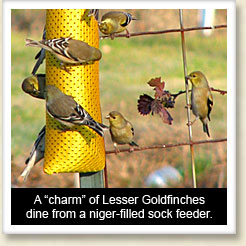Top Ten Tips for Terrific Bird Feeding
 When it comes to attracting our fine feathered friends to your own backyard, a little luck, perseverance, and the following ten tips can turn your bird feeding efforts into a soaring success.
When it comes to attracting our fine feathered friends to your own backyard, a little luck, perseverance, and the following ten tips can turn your bird feeding efforts into a soaring success.

Offer a wide variety of quality food.
While many birds can be drawn to a feeder full of black oil sunflower seeds, some clearly demonstrate a penchant for a particular cuisine. Nuttall’s Woodpeckers and Bewick’s Wrens love a snack of suet; Western Bluebirds can be enticed by a dish of meal worms; Lesser Goldfinches relish a sock full of niger; Hummingbirds and Hooded Orioles are both seduced by a sip of sugar water. You might start off with a quality mix containing several kinds of seed, then branch out, offering goodies to attract specific birds to your yard. Be sure to buy quality seed. The stuff offered at “big box” stores has often been sitting on a shelf halfway around the world for several months. You like your food fresh and so do the birds! And cheap seed usually contains a high percentage of fillers, like millet, that most wild birds simply ignore.

Use several types of feeders.
A wide assortment of birds, including Oak Titmice, House Finches, and Black-headed Grosbeaks, enjoy eating their dinner while safely suspended from a hanging feeder. However, some birds, like Spotted Towhees, Dark-eyed Juncos, and Mourning Doves, like to keep their feet closer to the ground while dining, preferring a low platform feeder. Meanwhile, Western Scrub Jays and White-breasted Nuthatches will precariously cling to a vertical suet cage while they eat. Tube feeders are a great place to start, but try an assortment of feeders to attract a wider selection of birds.

Locate your feeders carefully.
Birds like to dine in peace, so pick a quiet spot in your yard, away from foot traffic, pets, and children’s play areas. Of course, you’ll want to choose a spot with good visibility so you can observe your dinner guests.

Keep ‘em safe.
Another thing to keep in mind when placing your feeders is the overall safety of the birds. If you place a feeder next to a convenient hiding place for a cat, you’ll likely be feeding them instead of the birds. Low-lying shrubs could spell danger for birds, but a dense nearby tree offers a place of refuge for them.


Deny the uninvited.
Sometimes squirrels can be the bane of a birder’s existence. Their ravenous appetites drive them to deplete a feeder’s contents in no time. A suet cake that might last a family of woodpeckers two weeks can disappear in the course of an afternoon once a squirrel gets a bead on it. Luckily, many clever, effective, and sometimes downright entertaining methods have been devised to defeat even the most determined squirrel. Stop by Wild Birds & Gardens to see our selection of squirrel-proof feeders and marvel at the ingenuity involved.

Maintain clean feeders.
Just as you would probably prefer a spic and span restaurant, birds are more likely to frequent your feeders if they're clean and inviting. If your feeders look grungy or show signs of mold, empty out any remaining seed and pop 'em in the dishwasher (unless they're wood). Or clean the feeder with a 10% bleach solution, rinse well and let it air dry before refilling with seed. Alternately, bring 'em on by the store and, for a mere $5, a member of our staff will do the dirty work for you. (The proceeds are donated to the Wildlife Care Center.)

Provide a source of water.
Birds do not live by seed alone. Give them something to drink and bathe in and they’ll show their appreciation by returning frequently. A gurgling fountain is especially tempting to a bird, but a birdbath or even a small dish of water can be enticing. If your watering hole is static, be sure to change out the water regularly to prevent it from becoming a mosquito nursery.

Landscape with birds in mind.
No doubt about it, birds like a nice garden—one with mature trees to nest in, berry-bearing bushes to feed on, nectar-rich flowers to sip from, and plenty of insects to munch upon. And they definitely prefer a pesticide- and chemical-free environment. Whenever possible, rely upon organic gardening methods so you don’t inadvertently poison your birds.

Make it convenient.
Regardless of which feeder you choose or where you decide to put it, make sure it’s easy to get at, clean and refill. Otherwise it becomes another dreaded chore on your to-do list and is less likely to get done.

Exercise patience.
Sometimes it simply takes time for birds to discover your bountiful cornucopia of treats. Give it a few weeks before getting discouraged. Also, the number of birds visiting your yard may fluctuate from season to season as they pursue other activities or food sources. But follow the steps outlined above and they’ll be back before you know it.
Regardless of where you are in your bird feeding ventures, we'd be happy to help you find the right seed and feeders for your bird buddies. Stop by the store today!

